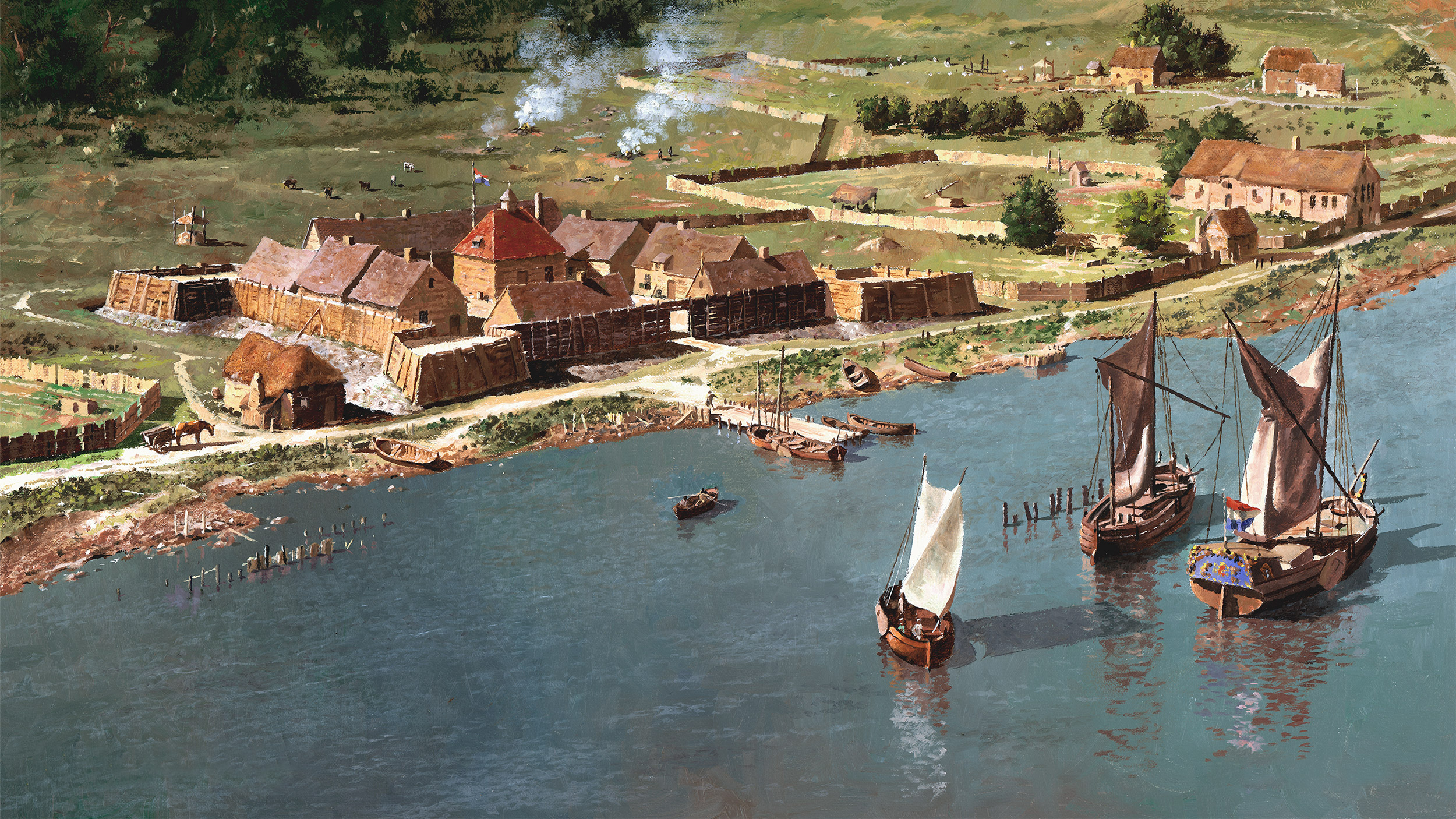Introduction to the Fort Orange Educational Guide
Created for teachers of the 4th and 7th grades, this educational guide provides five lessons that introduce students to Fort Orange and the world of New Netherland. Studying New Netherland—its foundation, purpose, and the complex dynamics of its diverse populations—is essential to students’ understanding of the history of New York. The wealth of archival resources, three-dimensional artifacts, and original research in the repositories of the Office of Cultural Education make teaching this history possible. Moreover, the richness of the resources pertaining to the Dutch development of New York makes this subject perfect for inquiry-based lessons that challenge students to investigate different types of evidence and explore life in New Netherland.
In these lessons students use digital images of archaeological collections, interviews with content specialists, and digital copies of archival material and artwork to answer Social Studies Framework-supporting questions and develop English Language Arts skills. Students will gain content knowledge about Fort Orange and the Dutch colony of New Netherland in the seventeenth century, as well as the skills for analyzing and interpreting primary sources.
The exhibition, “a small fort, which our people call Fort Orange,” at the New York State Museum and this educational guide were generously supported by the Dutch Culture USA program administered by the Consulate General of the Netherlands in New York. Additional essential support was provided by the Archives Partnership Trust.
Instructions for use of Fort Orange Online Educational Materials:
All of the slide presentations and student worksheets available below were created for optimal use with Google Drive and Google Classroom. If you do not have or do not want an account with Google (gmail), you can still view the slide presentations online OR easily download and save the documents as PDFs or Word Documents.

LESSON 1: Native American Daily Life Before Dutch Arrival
Learn about the Mohawks and Mohicans, Native American groups living in the area of Fort Orange.
- Historical Background: The Mohawks and the Mohicans
- Setting the Stage: Making Comparisons
- Activity #1: Where did the Mohawks and Mohicans live?
- Activity #2: Compare the Mohawk community to the Mohican community
- Activity #3: Analyze the artifacts left behind by the Mohawks and Mohicans
- Summative Assessment: Describing daily life
Lesson 1: Slide Presentation and Worksheet (Combined) via Google Slides | |
| Lesson 1: Slide Presentation | » Link to Google Slides |
| Lesson 1: Student Worksheet | » Link to Google Document » Download PDF (350 KB) |
| Lesson 1: Answer Key | » Link to Google Document |

Lesson 2: Trade with Fort Orange
What was the purpose of Fort Orange and how did Dutch settlers take advantage of their new settlement?
- Historical Background: Establishing Trade
- Setting the Stage: Analyzing Paintings
- Activity #1: What items did the Dutch offer to trade?
- Activity #2: How did the Mohicans and Mohawks use some of the items they received from the Dutch?
- Activity #3: What did the Dutch receive in exchange for their trade items?
- Summative Assessment: Writing a persuasive letter
Lesson 2: Slide Presentation and Worksheet (Combined) via Google Slides | |
| Lesson 2: Slide Presentation | » Link to Google Slides |
| Lesson 2: Student Worksheet | » Link to Google Document » Download PDF (350 KB) |
| Lesson 2: Answer Key | » Link to Google Document |

Lesson 3: Archaeology of Fort Orange
How does archaeology help us describe a place that no longer exists?
- Historical Background: Descriptions of Fort Orange
- Setting the Stage: Sourcing a Document, Catalina Trico’s Description of Fort Orange
- Activity #1: Where was Fort Orange located?
- Activity #2: How does archaeology help us describe a place that no longer exists?
- Activity #3: What did Fort Orange look like?
- Summative Assessment: Determining the reliability of information
Lesson 3: Slide Presentation and Worksheet (Combined) via Google Slides | |
| Lesson 3: Slide Presentation | » Link to Google Slides |
| Lesson 3: Student Worksheet | » Link to Google Document » Download PDF (400KB) |
| Lesson 3: Answer Key | » Link to Google Document |
| Lesson 3: VIDEO 1 | Len Tantillo: Painting History |
| Lesson 3: VIDEO 2 | Len Tantillo: Recreating Fort Orange |
| Lesson 3: VIDEO 3 | Paul Huey: Uncovering Fort Orange |
| Lesson 3: VIDEO 4 | Paul Huey & Joe McEvoy: Artifacts |
| Lesson 3: VIDEO 5 | Paul Huey: Locating Fort Orange |

Lesson 4: Economical & Political Tensions among the Dutch
What issues caused problems among the Dutch settlers living around Fort Orange?
- Historical Background: A Patroon, a Director, and a Village called Beverwijck
- Setting the Stage: Using Maps in Historical Thinking
- Activity #1: What complaints did Brant van Slichtenhorst have in 1648?
- Activity #2: How did the directors of the West India Company respond to Slichtenhorst?
- Summative Assessment: Understanding different perspectives
Lesson 4: Slide Presentation and Worksheet (Combined) via Google Slides | |
| Lesson 4: Slide Presentation | » Link to Google Slides |
| Lesson 4: Student Worksheet | » Link to Google Document » Download PDF |
| Lesson 4: Answer Key | » Link to Google Document |

Lesson 5: Riches of Global Commerce at Fort Orange
What kind of life did the Dutch build in New Netherland?
- Historical Background: The Dutch Golden Age
- Setting the Stage: What Was the Dutch Golden Age?
- Activity #1: Gallery Walk
- Activity #2: Analyzing Artifacts
- Summative Assessment: Putting it altogether
">Lesson 5: Slide Presentation and Worksheet (Combined) via Google Slides | |
| Lesson 5: Slide Presentation | » Link to Google Slides |
| Lesson 5: Student Worksheet | » Link to Google Document » Download PDF |
| Lesson 5: Answer Key | » Link to Google Document |


